Yi Luo
Department of Electrical Engineering, Columbia University, NY, USA
Scale-Aware Curriculum Learning for Ddata-Efficient Lung Nodule Detection with YOLOv11
Oct 30, 2025Abstract:Lung nodule detection in chest CT is crucial for early lung cancer diagnosis, yet existing deep learning approaches face challenges when deployed in clinical settings with limited annotated data. While curriculum learning has shown promise in improving model training, traditional static curriculum strategies fail in data-scarce scenarios. We propose Scale Adaptive Curriculum Learning (SACL), a novel training strategy that dynamically adjusts curriculum design based on available data scale. SACL introduces three key mechanisms:(1) adaptive epoch scheduling, (2) hard sample injection, and (3) scale-aware optimization. We evaluate SACL on the LUNA25 dataset using YOLOv11 as the base detector. Experimental results demonstrate that while SACL achieves comparable performance to static curriculum learning on the full dataset in mAP50, it shows significant advantages under data-limited conditions with 4.6%, 3.5%, and 2.0% improvements over baseline at 10%, 20%, and 50% of training data respectively. By enabling robust training across varying data scales without architectural modifications, SACL provides a practical solution for healthcare institutions to develop effective lung nodule detection systems despite limited annotation resources.
WAKE: Watermarking Audio with Key Enrichment
Jun 06, 2025

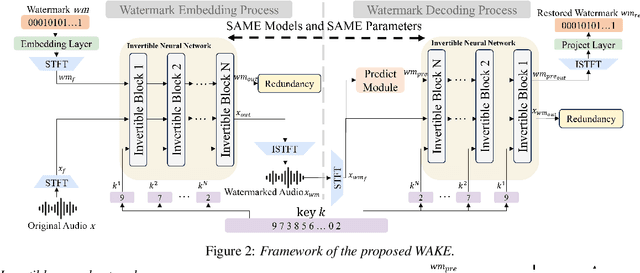
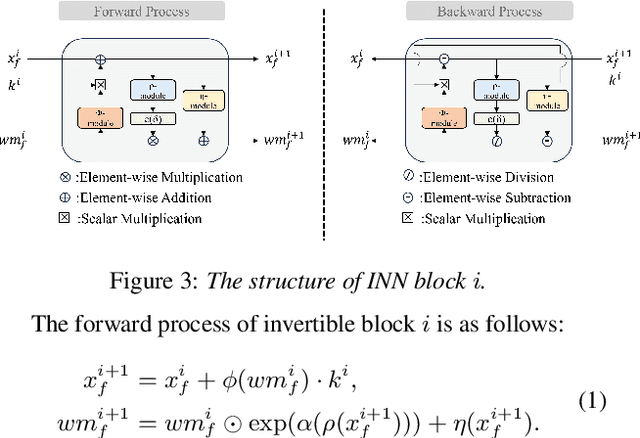
Abstract:As deep learning advances in audio generation, challenges in audio security and copyright protection highlight the need for robust audio watermarking. Recent neural network-based methods have made progress but still face three main issues: preventing unauthorized access, decoding initial watermarks after multiple embeddings, and embedding varying lengths of watermarks. To address these issues, we propose WAKE, the first key-controllable audio watermark framework. WAKE embeds watermarks using specific keys and recovers them with corresponding keys, enhancing security by making incorrect key decoding impossible. It also resolves the overwriting issue by allowing watermark decoding after multiple embeddings and supports variable-length watermark insertion. WAKE outperforms existing models in both watermarked audio quality and watermark detection accuracy. Code, more results, and demo page: https://thuhcsi.github.io/WAKE.
HiCaM: A Hierarchical-Causal Modification Framework for Long-Form Text Modification
May 30, 2025Abstract:Large Language Models (LLMs) have achieved remarkable success in various domains. However, when handling long-form text modification tasks, they still face two major problems: (1) producing undesired modifications by inappropriately altering or summarizing irrelevant content, and (2) missing necessary modifications to implicitly related passages that are crucial for maintaining document coherence. To address these issues, we propose HiCaM, a Hierarchical-Causal Modification framework that operates through a hierarchical summary tree and a causal graph. Furthermore, to evaluate HiCaM, we derive a multi-domain dataset from various benchmarks, providing a resource for assessing its effectiveness. Comprehensive evaluations on the dataset demonstrate significant improvements over strong LLMs, with our method achieving up to a 79.50\% win rate. These results highlight the comprehensiveness of our approach, showing consistent performance improvements across multiple models and domains.
Generalized Category Discovery in Event-Centric Contexts: Latent Pattern Mining with LLMs
May 29, 2025Abstract:Generalized Category Discovery (GCD) aims to classify both known and novel categories using partially labeled data that contains only known classes. Despite achieving strong performance on existing benchmarks, current textual GCD methods lack sufficient validation in realistic settings. We introduce Event-Centric GCD (EC-GCD), characterized by long, complex narratives and highly imbalanced class distributions, posing two main challenges: (1) divergent clustering versus classification groupings caused by subjective criteria, and (2) Unfair alignment for minority classes. To tackle these, we propose PaMA, a framework leveraging LLMs to extract and refine event patterns for improved cluster-class alignment. Additionally, a ranking-filtering-mining pipeline ensures balanced representation of prototypes across imbalanced categories. Evaluations on two EC-GCD benchmarks, including a newly constructed Scam Report dataset, demonstrate that PaMA outperforms prior methods with up to 12.58% H-score gains, while maintaining strong generalization on base GCD datasets.
Inductive Link Prediction on N-ary Relational Facts via Semantic Hypergraph Reasoning
Mar 26, 2025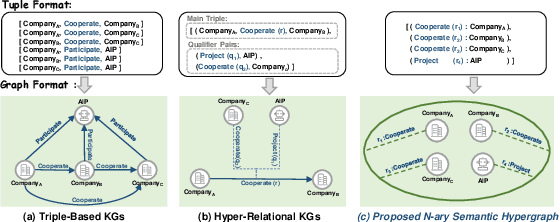
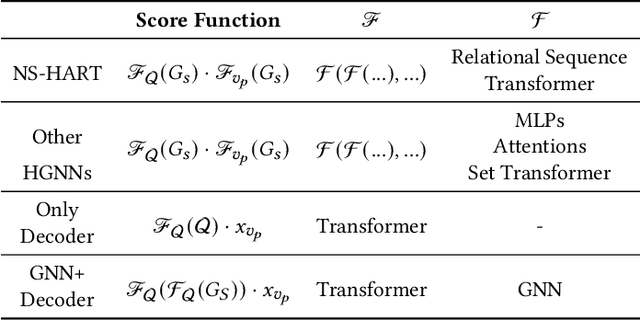
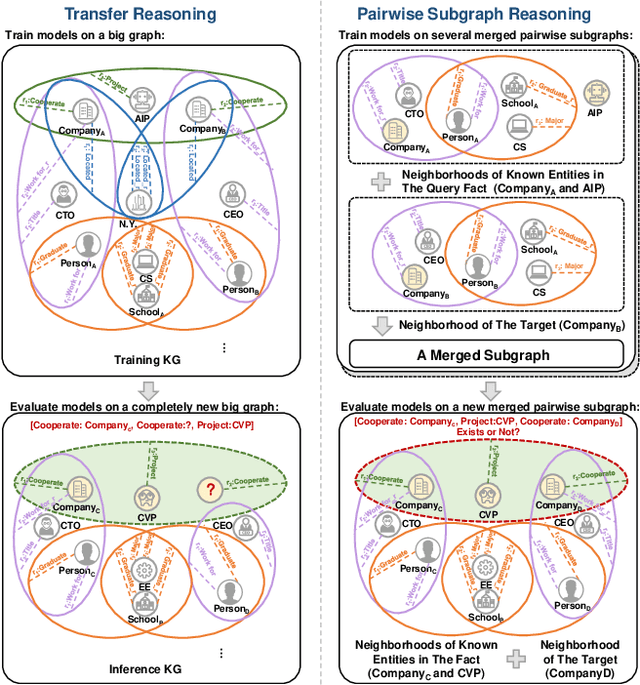

Abstract:N-ary relational facts represent semantic correlations among more than two entities. While recent studies have developed link prediction (LP) methods to infer missing relations for knowledge graphs (KGs) containing n-ary relational facts, they are generally limited to transductive settings. Fully inductive settings, where predictions are made on previously unseen entities, remain a significant challenge. As existing methods are mainly entity embedding-based, they struggle to capture entity-independent logical rules. To fill in this gap, we propose an n-ary subgraph reasoning framework for fully inductive link prediction (ILP) on n-ary relational facts. This framework reasons over local subgraphs and has a strong inductive inference ability to capture n-ary patterns. Specifically, we introduce a novel graph structure, the n-ary semantic hypergraph, to facilitate subgraph extraction. Moreover, we develop a subgraph aggregating network, NS-HART, to effectively mine complex semantic correlations within subgraphs. Theoretically, we provide a thorough analysis from the score function optimization perspective to shed light on NS-HART's effectiveness for n-ary ILP tasks. Empirically, we conduct extensive experiments on a series of inductive benchmarks, including transfer reasoning (with and without entity features) and pairwise subgraph reasoning. The results highlight the superiority of the n-ary subgraph reasoning framework and the exceptional inductive ability of NS-HART. The source code of this paper has been made publicly available at https://github.com/yin-gz/Nary-Inductive-SubGraph.
A Language Vision Model Approach for Automated Tumor Contouring in Radiation Oncology
Mar 19, 2025



Abstract:Background: Lung cancer ranks as the leading cause of cancer-related mortality worldwide. The complexity of tumor delineation, crucial for radiation therapy, requires expertise often unavailable in resource-limited settings. Artificial Intelligence(AI), particularly with advancements in deep learning (DL) and natural language processing (NLP), offers potential solutions yet is challenged by high false positive rates. Purpose: The Oncology Contouring Copilot (OCC) system is developed to leverage oncologist expertise for precise tumor contouring using textual descriptions, aiming to increase the efficiency of oncological workflows by combining the strengths of AI with human oversight. Methods: Our OCC system initially identifies nodule candidates from CT scans. Employing Language Vision Models (LVMs) like GPT-4V, OCC then effectively reduces false positives with clinical descriptive texts, merging textual and visual data to automate tumor delineation, designed to elevate the quality of oncology care by incorporating knowledge from experienced domain experts. Results: Deployments of the OCC system resulted in a significant reduction in the false discovery rate by 35.0%, a 72.4% decrease in false positives per scan, and an F1-score of 0.652 across our dataset for unbiased evaluation. Conclusions: OCC represents a significant advance in oncology care, particularly through the use of the latest LVMs to improve contouring results by (1) streamlining oncology treatment workflows by optimizing tumor delineation, reducing manual processes; (2) offering a scalable and intuitive framework to reduce false positives in radiotherapy planning using LVMs; (3) introducing novel medical language vision prompt techniques to minimize LVMs hallucinations with ablation study, and (4) conducting a comparative analysis of LVMs, highlighting their potential in addressing medical language vision challenges.
MuQ: Self-Supervised Music Representation Learning with Mel Residual Vector Quantization
Jan 03, 2025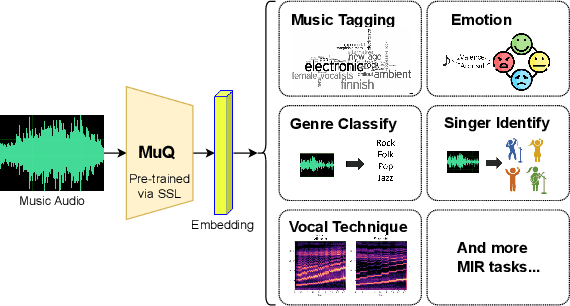



Abstract:Recent years have witnessed the success of foundation models pre-trained with self-supervised learning (SSL) in various music informatics understanding tasks, including music tagging, instrument classification, key detection, and more. In this paper, we propose a self-supervised music representation learning model for music understanding. Distinguished from previous studies adopting random projection or existing neural codec, the proposed model, named MuQ, is trained to predict tokens generated by Mel Residual Vector Quantization (Mel-RVQ). Our Mel-RVQ utilizes residual linear projection structure for Mel spectrum quantization to enhance the stability and efficiency of target extraction and lead to better performance. Experiments in a large variety of downstream tasks demonstrate that MuQ outperforms previous self-supervised music representation models with only 0.9K hours of open-source pre-training data. Scaling up the data to over 160K hours and adopting iterative training consistently improve the model performance. To further validate the strength of our model, we present MuQ-MuLan, a joint music-text embedding model based on contrastive learning, which achieves state-of-the-art performance in the zero-shot music tagging task on the MagnaTagATune dataset. Code and checkpoints are open source in https://github.com/tencent-ailab/MuQ.
RecConv: Efficient Recursive Convolutions for Multi-Frequency Representations
Dec 27, 2024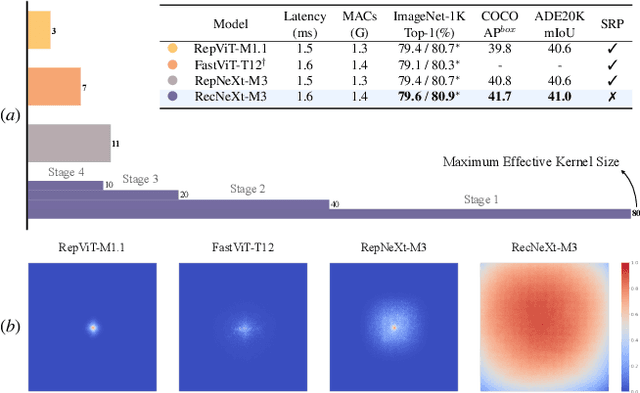
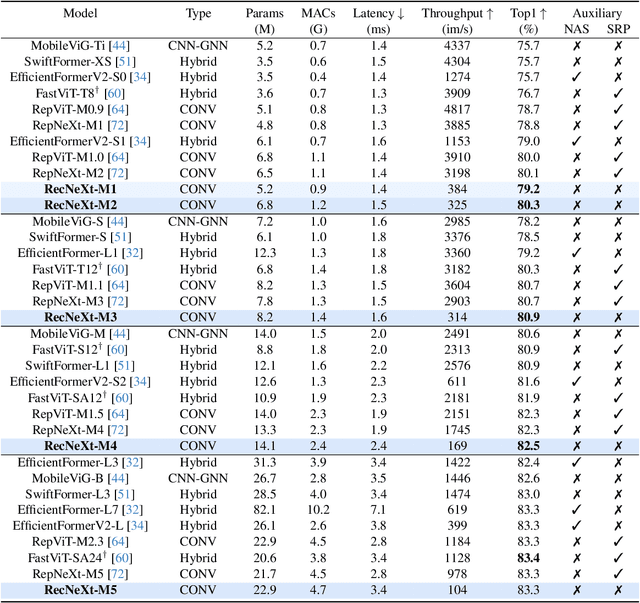
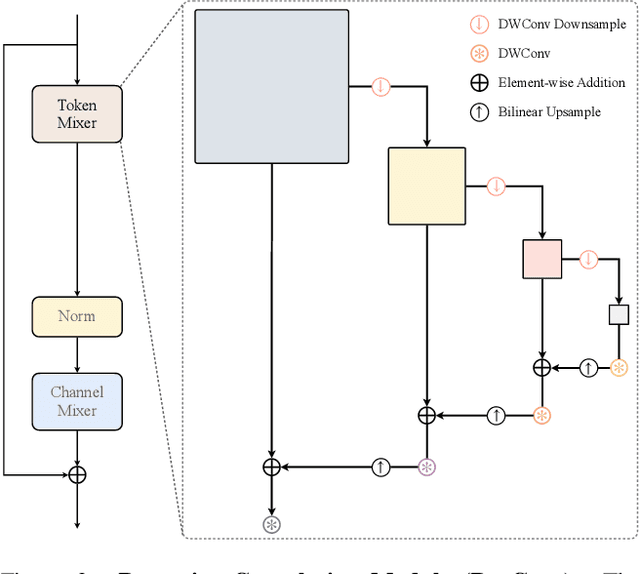

Abstract:Recent advances in vision transformers (ViTs) have demonstrated the advantage of global modeling capabilities, prompting widespread integration of large-kernel convolutions for enlarging the effective receptive field (ERF). However, the quadratic scaling of parameter count and computational complexity (FLOPs) with respect to kernel size poses significant efficiency and optimization challenges. This paper introduces RecConv, a recursive decomposition strategy that efficiently constructs multi-frequency representations using small-kernel convolutions. RecConv establishes a linear relationship between parameter growth and decomposing levels which determines the effective kernel size $k\times 2^\ell$ for a base kernel $k$ and $\ell$ levels of decomposition, while maintaining constant FLOPs regardless of the ERF expansion. Specifically, RecConv achieves a parameter expansion of only $\ell+2$ times and a maximum FLOPs increase of $5/3$ times, compared to the exponential growth ($4^\ell$) of standard and depthwise convolutions. RecNeXt-M3 outperforms RepViT-M1.1 by 1.9 $AP^{box}$ on COCO with similar FLOPs. This innovation provides a promising avenue towards designing efficient and compact networks across various modalities. Codes and models can be found at \url{https://github.com/suous/RecNeXt}.
From Intention To Implementation: Automating Biomedical Research via LLMs
Dec 12, 2024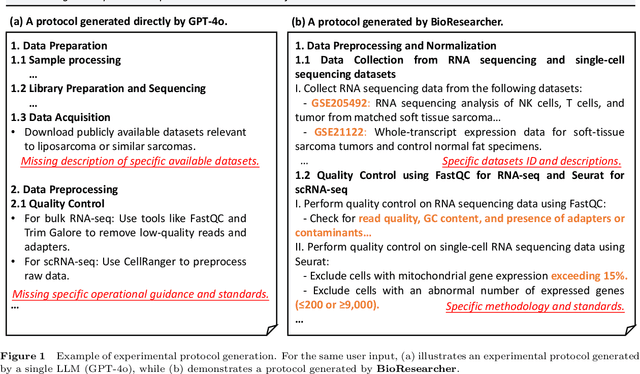

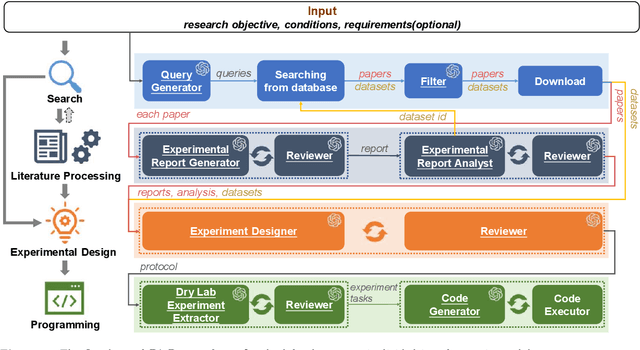

Abstract:Conventional biomedical research is increasingly labor-intensive due to the exponential growth of scientific literature and datasets. Artificial intelligence (AI), particularly Large Language Models (LLMs), has the potential to revolutionize this process by automating various steps. Still, significant challenges remain, including the need for multidisciplinary expertise, logicality of experimental design, and performance measurements. This paper introduces BioResearcher, the first end-to-end automated system designed to streamline the entire biomedical research process involving dry lab experiments. BioResearcher employs a modular multi-agent architecture, integrating specialized agents for search, literature processing, experimental design, and programming. By decomposing complex tasks into logically related sub-tasks and utilizing a hierarchical learning approach, BioResearcher effectively addresses the challenges of multidisciplinary requirements and logical complexity. Furthermore, BioResearcher incorporates an LLM-based reviewer for in-process quality control and introduces novel evaluation metrics to assess the quality and automation of experimental protocols. BioResearcher successfully achieves an average execution success rate of 63.07% across eight previously unmet research objectives. The generated protocols averagely outperform typical agent systems by 22.0% on five quality metrics. The system demonstrates significant potential to reduce researchers' workloads and accelerate biomedical discoveries, paving the way for future innovations in automated research systems.
Infant Agent: A Tool-Integrated, Logic-Driven Agent with Cost-Effective API Usage
Nov 02, 2024



Abstract:Despite the impressive capabilities of large language models (LLMs), they currently exhibit two primary limitations, \textbf{\uppercase\expandafter{\romannumeral 1}}: They struggle to \textbf{autonomously solve the real world engineering problem}. \textbf{\uppercase\expandafter{\romannumeral 2}}: They remain \textbf{challenged in reasoning through complex logic problems}. To address these challenges, we developed the \textsc{Infant Agent}, integrating task-aware functions, operators, a hierarchical management system, and a memory retrieval mechanism. Together, these components enable large language models to sustain extended reasoning processes and handle complex, multi-step tasks efficiently, all while significantly reducing API costs. Using the \textsc{Infant Agent}, GPT-4o's accuracy on the SWE-bench-lite dataset rises from $\mathbf{0.33\%}$ to $\mathbf{30\%}$, and in the AIME-2024 mathematics competition, it increases GPT-4o's accuracy from $\mathbf{13.3\%}$ to $\mathbf{37\%}$.
 Add to Chrome
Add to Chrome Add to Firefox
Add to Firefox Add to Edge
Add to Edge